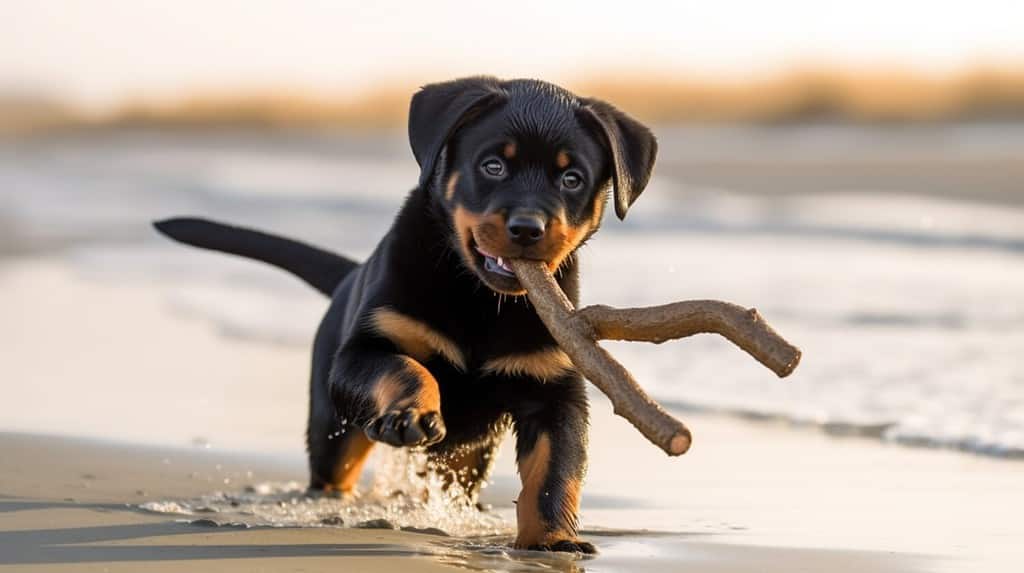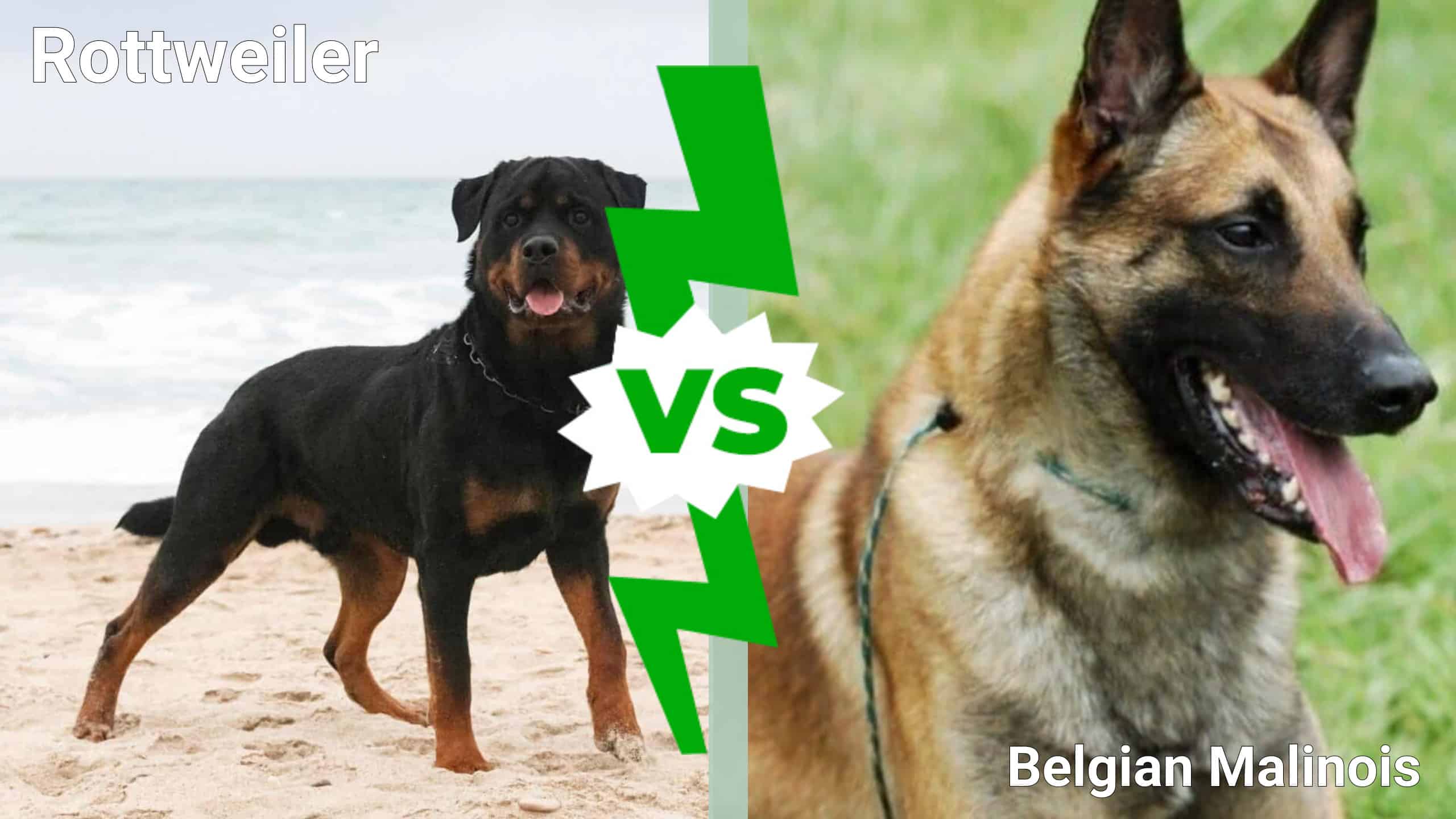Rottweilers and Belgian Malinois are both serious guard dogs. They were both originally bred to guard livestock, and their guarding instincts have since been transferred to humans and property.
Both are very devoted to their families, which is why many decide to adopt them. However, they both require a lot of work. Socialization and training are absolutely necessary to make these breeds well-adapted and social. Therefore, we only recommend them to experienced dog owners.
That said, that’s about where the similarities end. These dogs are extremely different despite their common origin and purpose. Rottweilers weigh a lot more than Belgian Malinois, for instance. Belgian Malinois are also active, requiring more exercise.
That’s not where the differences end, either. Keep reading for all the differences between these two breeds.
Rottweiler vs. Belgian Malinois: A Comparison
| Characteristic | Rottweiler | Belgian Malinois |
|---|---|---|
| Origin | Germany | Belgium |
| Size | Large | Medium to Large |
| Weight | 95-135 lbs | 55-75 lbs |
| Height | 22-27 in | 22-26 in |
| Lifespan | 9-10 years | 14-16 years |
| Coat | Short and dense | Short and dense |
| Coat Colors | Black with tan markings | Tan with black overlay |
| Temperament | Loyal, confident, and protective | Intelligent, energetic, and driven |
| Trainability | Intelligent and trainable | Highly trainable |
| Activity Level | Moderate | High |
| Grooming Needs | Low to moderate | Low |
| Exercise Requirements | Regular exercise and walks | High, ample activity |
| Suitability as a pet | Good family dog with proper socialization | Best suited for active, experienced families |
| Specialization | Guarding and protection work | Police and military work; herding |
Key Differences Between Rottweiler and Belgian Malinois
While these dogs are both protective and often used for the same purposes, they are very different from each other. For instance, Belgian Malinois are much more active, so they do best in a very active family. The size difference is also somewhat significant. Rottweilers are far larger than Belgian Malinois.
Origin and Purpose

German Malinois are brave and protective, making them fierce guard dogs.
©Bianca Grueneberg/Shutterstock.com
The Belgian malinois is one of the four varieties of Belgian Shepherd dogs. Today, they are by far one of the most popular, while some of the other varieties are much harder to find. This breed was initially developed in the city of Malines in Belgium, hence its name.
Originally, they were bred as herding dogs to work on farms. They guarded and helped move livestock around.
Due to their intelligence and versatility, they have evolved into exceptional working dogs, though. They excel at many different roles, such as police work, military service, search and rescue operations, detection work, and service dogs.
Today, they are well-loved thanks to their work ethic and trainability. They are easily one of the most trainable breeds out there.
Rottweilers are a little bit different. They date back to ancient Roman times when they were used to herd and guard cattle. Their name comes from a town they were developed in – Rottweil, Germany.
They were also used to pull carts and guard the property in the carts. That’s one reason why they are so large and muscular. Today, they still have these protective instincts, which makes them great guard dogs.
Size and Weight
The Belgian Malinois is a medium to large-sized dog breed. An adult male typically weighs 55 to 75 pounds and can stand up to 26 inches at the shoulders.
On the other hand, Rottweilers are much larger. Males can weigh up to 135 pounds and stand just an inch taller than the Belgian Malinois.
Coat and Color
These dogs have a similar coat on the surface. However, it is actually quite different once you get into it.
The Belgian Malinois has a short, straight, and dense coat that provides protection and requires minimal grooming. The coat color is predominantly tan with a black overlay, and they often have a distinctive black mask on their face.
Of course, this is their usual color. Different dogs do differ substantially and may not follow this pattern. Working dogs are bred for their characteristics and skills – not appearance.
Rottweilers also have a short, dense coat that is weather-resistant. Their coat color is primarily black, with well-defined tan markings on specific areas, including the chest, legs, cheeks, and eyebrows.
Temperament and Energy Levels

Rottweilers tend to be more laidback than other canines.
©Donamen/Shutterstock.com
These dogs are both used for guarding purposes. Both of them have guarding instincts. However, they differ substantially in the details of their temperament.
The Belgian Malinois is known for being extremely intelligent and energetic. They have a high drive and require plenty of mental stimulation. They do best when they are given a job to do, so they don’t always make great family dogs.
These dogs are loyal and affectionate and form strong bonds with their families. They make excellent police dogs.
The Rottweiler is a little bit different. They’re often calmer and require less exercise. They’re extremely confident and also have stronger instincts. While they have a lower energy level than Belgian Malinois, they still need regular exercise and mental stimulation to stay happy and healthy.
They do require early socialization and training, though. It’s absolutely required to ensure they’re stable, well-adjusted dogs.
Health
Both of these breeds are generally robust and healthy. They’re working breeds, after all. Having an unhealthy guard dog just doesn’t work. However, they can still be susceptible to genetic conditions. Here is what you can expect from each breed:
Belgian Malinois
- Hip Dysplasia: Like many large and medium-sized breeds, Belgian Malinois can be prone to hip dysplasia, a genetic condition where the hip joint doesn’t fit properly into the hip socket. This can lead to discomfort and arthritis as the dog ages.
- Elbow Dysplasia: Elbow dysplasia is another common joint issue in Malinois. It occurs due to improper elbow joint development and can lead to lameness and pain.
- Progressive Retinal Atrophy (PRA): PRA is an inherited eye disease that can lead to vision loss and eventually blindness.
- Epilepsy: Some Malinois may develop epilepsy, a neurological disorder characterized by recurring seizures.
- Gastric Dilatation-Volvulus (GDV): Also known as bloat, this condition is more common in deep-chested breeds like the Malinois. It is a life-threatening emergency where the stomach twists, causing gas and fluid buildup.
Rottweiler
- Hip Dysplasia: Rottweilers are particularly prone to hip dysplasia, as they are so large. This condition can be painful and limit their mobility. Sometimes, it can be cured with surgery.
- Elbow Dysplasia: Elbow dysplasia is very similar to hip dysplasia but in the elbows. It’s another concern for Rottweilers.
- Heart Conditions: Rottweilers are susceptible to certain heart conditions, like dilated cardiomyopathy. These can easily be deadly if not properly treated.
- Osteosarcoma: This bone cancer is more common in Rottweilers than in other breeds.
- Hyperthyroidism: Rottweilers can develop an underactive thyroid gland, leading to weight gain and lethargy.
Wrapping Up Rottweiler vs. Belgian Malinois

While the Rottweiler and Belgian Malinois are very similar, they are distinct in several ways. The Belgian Malinois is a very active, trainable dog that practically requires having a job to do. They were originally bred for herding, but they’re often used for police and military work today.
They have a medium to large size, a short tan coat with black overlay, and can be reserved around strangers. Their high energy level and strong work drive require an active and experienced owner who can provide ample mental and physical stimulation.
On the other side, you have the Rottweiler. This breed is much larger and more laid-back than the Belgian Malinois. They don’t require as much exercise, though they are still active dogs.
Historically used as cattle herders and draft dogs, they are now known for their loyalty and protective nature, making them excellent guard dogs and family protectors.
Rottweilers have short black coats with distinctive tan markings, and they are generally more accepting of strangers compared to the reserved nature of the Belgian Malinois. They are best suited for families seeking a devoted companion with a moderate activity level, but they still require regular exercise and early socialization.
Both breeds can be great companions. However, potential owners should be careful regarding how much care these breeds need. They aren’t for the faint of heart.
What Dogs Do Navy SEALS Use?

Belgian Malinois are lighter, leaner, and more compact in frame than German Shepherds which are extremely beneficial to certain missions.
The Belgian Malinois, also known as the Belgian shepherd, is a highly intelligent breed that is known for its incredible speed and relatively compact size. They are ideal for use by various Special Operations units, in particular the Navy SEALS, and are the primary dog breed used as a Combat Assault Dog (CAD). This breed’s speed alone is something that is highly prized as it helps create a tactical advantage in this elite military force.
These dogs are favored for many of their highly sought-after traits – agility, obedience, high intellect, speed, and loyalty. They are lighter, leaner, and with a more compact frame than the traditional CAD German shepherd, which is extremely beneficial when it comes to missions that involve tandem parachute jumping or rappelling, which is one of the many fundamental parts of a SEAL’s mission.
Ready to discover the top 10 cutest dog breeds in the entire world?
How about the fastest dogs, the largest dogs and those that are -- quite frankly -- just the kindest dogs on the planet? Each day, AZ Animals sends out lists just like this to our thousands of email subscribers. And the best part? It's FREE. Join today by entering your email below.
Thank you for reading! Have some feedback for us? Contact the AZ Animals editorial team.








